⚠️UNDIAGNOSED PNEUMONIA OUTBREAK—An emerging large outbreak of pneumonia in China, with pediatric hospitals in Beijing, Liaoning overwhelmed with sick children, & many schools suspended. Beijing Children's Hospital overflowing. 🧵on what we know so far:
2) An alert 🔔 went out on ProMed epidemic network last night. They warn of an unknown “walking pneumonia” without coughing, but HIGH FEVER + pulmonary nodules. Hospital’s full of kids now on IV drips.
Chinese report
promedmail.org/promed-post/?i…
ftvnews.com.tw/news/detail/20…

Chinese report
promedmail.org/promed-post/?i…
ftvnews.com.tw/news/detail/20…
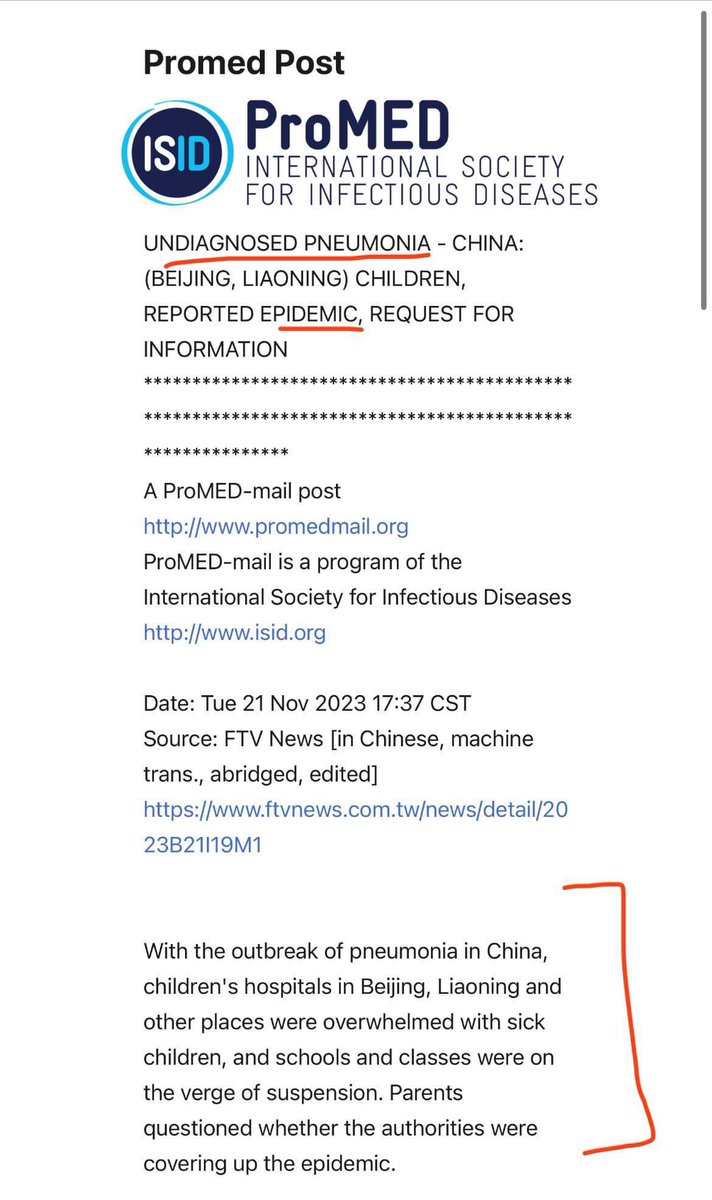
3) Some school classes have even been canceled completely. Not only are all students sick, but teachers are also infected with pneumonia. ...
Mr. [W], a Beijing citizen: "Now you are not allowed to report to school. If you have any symptoms such as fever, cold, cough and then you are hospitalized”

Mr. [W], a Beijing citizen: "Now you are not allowed to report to school. If you have any symptoms such as fever, cold, cough and then you are hospitalized”

4) “It is too early to project whether this could be another pandemic but as a wise influenza virologist once said to me "The pandemic clock is ticking, we just do not know what time it is."”
5) Also of note- Beijing and Liaoning are 800 km apart!! This epidemic isn’t localized anymore. That worries me a lot. 🤔
Chinese hospitals have been “overwhelmed with sick children” as an outbreak of pneumonia escalates in cities across the country.
telegraph.co.uk/global-health/…
Chinese hospitals have been “overwhelmed with sick children” as an outbreak of pneumonia escalates in cities across the country.
telegraph.co.uk/global-health/…
6) In an editor’s note, ProMed said: “This report suggests a widespread outbreak of an undiagnosed respiratory illness ... It is not at all clear when this outbreak started as it would be unusual for so many children to be affected so quickly.“ — this is worrisome too.
7) one speculation—outbreak could be a type of Mycoplasma pneumoniae, aka “walking pneumonia”, reportedly surging in China. ➡️But this is a vague lumping. We don’t know the infectious agent. And this is not typical “walking pneumonia” since this new outbreak is not mild.
8) Let this photo sink in— students in China keep doing homework in the hospital while getting IV fluids.
What a world.
What a world.
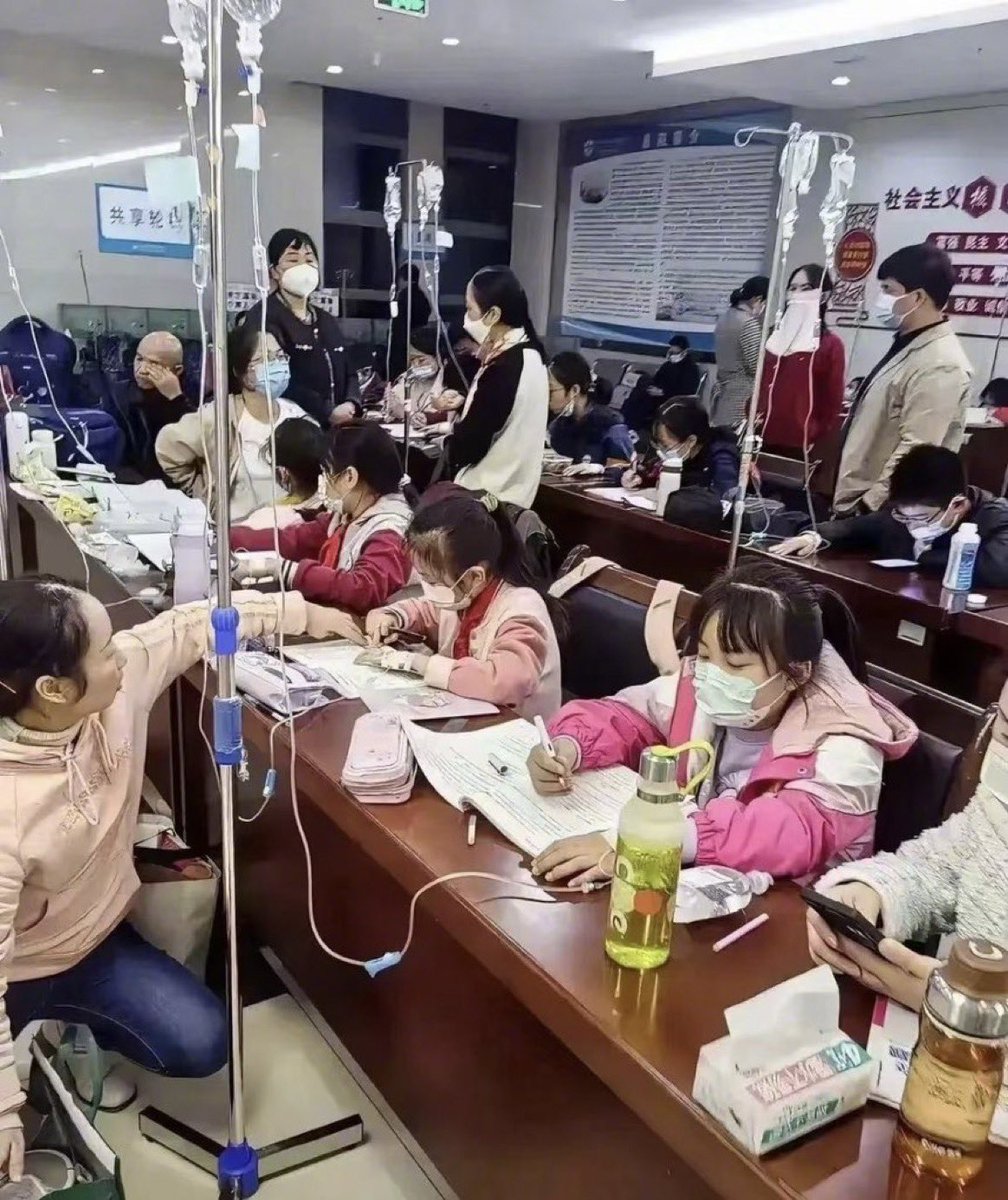
9) The pneumonia started surging
in October… doctors noted also that:
“Compared to previous years, we found more patients with mixed infections, **drug resistance**.”
Maybe it’s a new virus or it’s maybe it’s a nasty antibiotic-resistant bacteria.
chinadaily.com.cn/a/202310/24/WS…
in October… doctors noted also that:
“Compared to previous years, we found more patients with mixed infections, **drug resistance**.”
Maybe it’s a new virus or it’s maybe it’s a nasty antibiotic-resistant bacteria.
chinadaily.com.cn/a/202310/24/WS…
10) Here are direct reports from the scene on Chinese from locals— I’ll try to provide excerpts from this conversation…
=====
So there was no movement for a whole hour after No. 406, and the parents couldn't bear it.
Call the police. The police are here. They understand the situation and go to another hospital.
Triage, triage is not moving, Children’s Hospital is no longer treating children.
The institute is also full of people. These parents are from the institute and children
The hospital didn't call me.
02:00
This is the current overall situation, and we all should consider it together
judge.
02:01
02:00
01:50
The situation is indeed difficult, not only for the hospital, but also for the patients and the police.

=====
So there was no movement for a whole hour after No. 406, and the parents couldn't bear it.
Call the police. The police are here. They understand the situation and go to another hospital.
Triage, triage is not moving, Children’s Hospital is no longer treating children.
The institute is also full of people. These parents are from the institute and children
The hospital didn't call me.
02:00
This is the current overall situation, and we all should consider it together
judge.
02:01
02:00
01:50
The situation is indeed difficult, not only for the hospital, but also for the patients and the police.
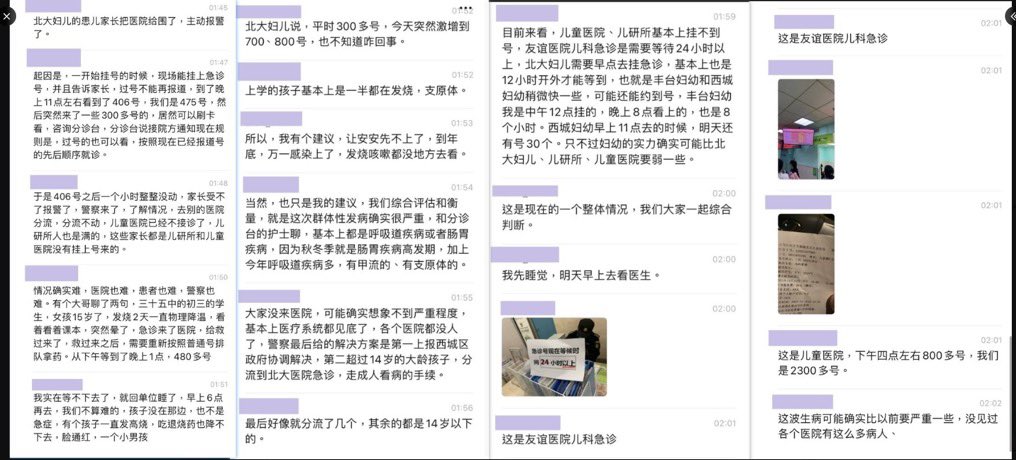
11) “Disaster. I had a chat with an older brother, who is a student in the third year of junior high school in No. 35 Middle School.
She is a 15-year-old girl. She has had a fever for 2 days and has been cooling down physically. See
I was looking at the textbook and suddenly fainted. The emergency department came to the hospital for help.”

She is a 15-year-old girl. She has had a fever for 2 days and has been cooling down physically. See
I was looking at the textbook and suddenly fainted. The emergency department came to the hospital for help.”
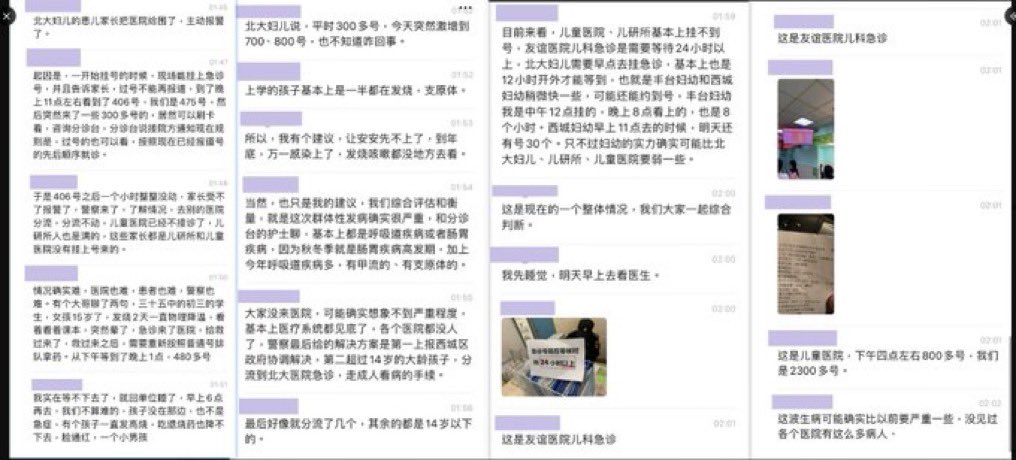
12) “It's an emergency. A child has been having a high fever and it can't be brought down even by taking antipyretics.
Go down, face red, a little boy
01:52
Basically half of the children who go to school have fever and [pneumonia].”
Go down, face red, a little boy
01:52
Basically half of the children who go to school have fever and [pneumonia].”

13) “01:55
If you haven’t come to the hospital, you may not be able to imagine the severity.
Basically, the medical system is at its lowest point, and every hospital is empty of people.
Well, the final solution given by the police was to report it to Xicheng District first
The government coordinates the solution, and the second oldest children over 14 years old are divided into
He went to the emergency room of Peking University Hospital and went through the procedures for adult medical treatment.
01:59
At present, children’s hospitals and pediatric research institutes are basically unable to get admission
No., the pediatric emergency department of Friendship Hospital requires waiting for more than 24 hours.”

If you haven’t come to the hospital, you may not be able to imagine the severity.
Basically, the medical system is at its lowest point, and every hospital is empty of people.
Well, the final solution given by the police was to report it to Xicheng District first
The government coordinates the solution, and the second oldest children over 14 years old are divided into
He went to the emergency room of Peking University Hospital and went through the procedures for adult medical treatment.
01:59
At present, children’s hospitals and pediatric research institutes are basically unable to get admission
No., the pediatric emergency department of Friendship Hospital requires waiting for more than 24 hours.”

14) The respiratory department at Vietnam's children's hospital (HCMC) has run out of beds, forcing patients to lie in hammocks in the hallway. Video via @trongnhan9500
@trongnhan9500 15) Is it mild? I’m not so sure. But this worries me— “One-tenth of the patients come from out of town … because bronchoscopies are unavailable in their hometown.” ➡️According to Chinese CDC, bronchoscopies are not needed for mild cases of the infection.”
sixthtone.com/news/1014131
sixthtone.com/news/1014131
@trongnhan9500 16) China’s official news outlet blames the outbreak on “Influenza, adenovirus, RSV, rhinovirus”,… but says something further. They don’t acknowledge any unknown source of the outbreak… is it just those 3 viruses, or coverup of something else? 🤔 

@trongnhan9500 17) there has been a reported rise in influenza A (brown) and discussions of flu and many other viruses on Chinese Weibo (WeChat). Not sure if it’s the cause of this surge, but worrisome… trying my best to find clues what it is…
whatsonweibo.com/sick-kids-worr…

whatsonweibo.com/sick-kids-worr…

18) China is a place of extremes for emergence of outbreaks and what it can do to a society. Last winter, after dust settled, experts estimated 2-3 million people died when COVID mitigations were dropped. It was thermonuclear bad. Hope this winter won’t be the same.
https://twitter.com/drericding/status/1604748747640119296
19) This graph showing a sudden spike in H9N2 was provided by @EPIWATCH_bsp, an AI-driven system that scans for signals worldwide. And their system found an uptick in avian H9N2 reports in China that stick out in the last 2 weeks. @CIDRAP also notes an case of H9N2 in a HK report.
EpiWatch founder @Globalbiosec notes that:
“A google search in English will only give you a fraction of what is out there. our early research on Asian languages showed you will miss most reports if you do not search in specific disease and syndrome terms in original languages. Over 70% of our intel is NOT in English.”


EpiWatch founder @Globalbiosec notes that:
“A google search in English will only give you a fraction of what is out there. our early research on Asian languages showed you will miss most reports if you do not search in specific disease and syndrome terms in original languages. Over 70% of our intel is NOT in English.”
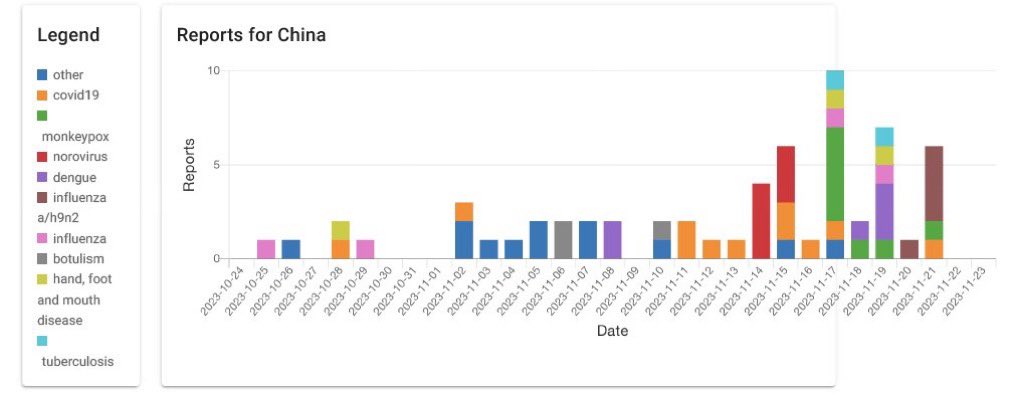
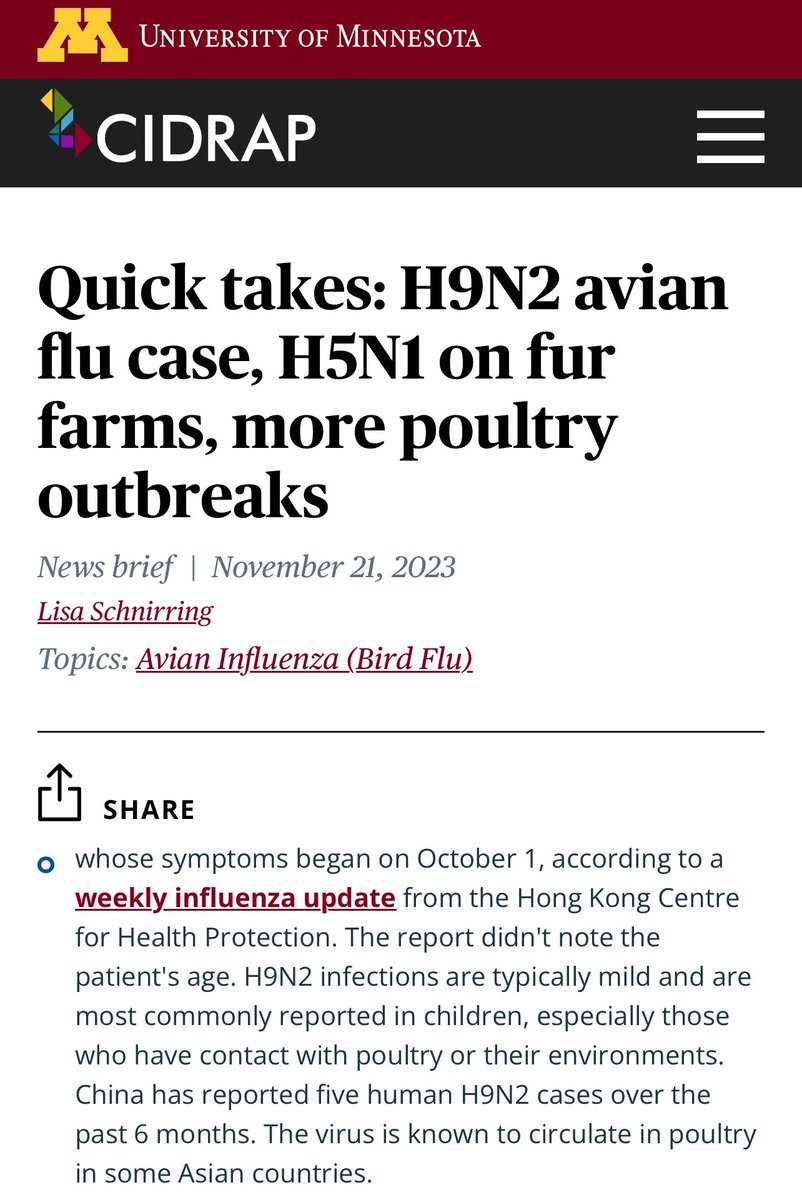
@EPIWATCH_bsp @CIDRAP 20) I pray it’s not an avian flu that jumped to humans. We will know more in the coming days. I’ll keep folks updated. Meantime, please SUBSCRIBE (for free, no paywall) for updates later. Thank you:
drericding.substack.com/subscribe
drericding.substack.com/subscribe
@EPIWATCH_bsp @CIDRAP 21) the WHO has made an official request to China for more data on the unknown pneumonia outbreak. But while their post is vague, the WHO summary is clearly worried to make their demand to China 🇨🇳 public. It suggest the situation of my thread 🧵 above is very real…
https://twitter.com/who/status/1727452971816935537
• • •
Missing some Tweet in this thread? You can try to
force a refresh


















